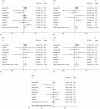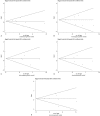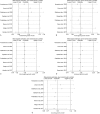Association of TFPI polymorphisms rs8176592, rs10931292, and rs10153820 with venous thrombosis: A meta-analysis
- PMID: 30896671
- PMCID: PMC6709305
- DOI: 10.1097/MD.0000000000014978
Association of TFPI polymorphisms rs8176592, rs10931292, and rs10153820 with venous thrombosis: A meta-analysis
Abstract
Background: Tissue factor pathway inhibitor (TFPI) polymorphisms are known to be involved in venous thrombosis; however, any correlation between the TFPI polymorphisms rs8176592, rs10931292, and rs10153820 and venous thrombosis remains controversial. This meta-analysis aimed to elucidate the relationship between these TFPI polymorphisms and the susceptibility to venous thrombosis.
Methods: A literature search for relevant studies was conducted in PubMed, Embase, Cochrane Library, China National Knowledge Infrastructure (CNKI), and Wanfang Med Online databases. Odds ratios (ORs) and their corresponding 95% confidence intervals (95% CIs) were calculated using fixed-effect/random-effect models by the STATA 12.0 software. Sources of heterogeneity were analyzed by subgroup analysis.
Results: Eleven case-control studies involving 3740 subjects (1362 venous thrombosis patients and 2378 healthy controls) were included. The TFPI rs8176592 polymorphism was associated with increased risk of venous thrombosis in the whole population, while no significant association was found between rs10931292/rs10153820 and venous thrombosis. In subgroup analysis based on ethnicity, an increased risk was observed with rs8176592 polymorphism in Asians (Recessive model, OR = 1.48, 95% CI = 1.06-2.07, P = .023). An increased risk associated with rs10931292 was identified in non-Asians (Recessive model, OR = 1.42, 95% CI = 1.03-1.97, P = .033). No significant association was found in either Asians or non-Asians with the rs10153820 polymorphism. In subgroup analysis based on source of controls, increased risks were identified in the hospital-based group with rs8176592 polymorphism and in the population-based group with rs10931292 polymorphism, whereas decreased risk was identified in the hospital-based group with the rs10931292 and rs10153820 polymorphisms.
Conclusion: Meta-analysis suggested that different TFPI polymorphisms may have different associations with venous thrombosis. TFPI rs8176592 polymorphism may increase the risk of venous thrombosis, especially in Asians and hospital-based patients. The TFPI rs10931292 polymorphism may increase the venous thrombosis risk for both non-Asians and population-based patients. Moreover, rs10931292 and rs10153820 polymorphisms of TFPI may decrease the risk of venous thrombosis for hospital-based patients.
Conflict of interest statement
The authors have no conflicts of interest to disclose.
Figures




Similar articles
-
Genetic determinants of tissue factor pathway inhibitor plasma levels.Thromb Haemost. 2015 Aug;114(2):245-57. doi: 10.1160/TH14-12-1043. Epub 2015 Apr 16. Thromb Haemost. 2015. PMID: 25879386
-
Polymorphisms in antithrombin and in tissue factor pathway inhibitor genes are associated with recurrent pregnancy loss.Thromb Haemost. 2012 Oct;108(4):693-700. doi: 10.1160/TH12-03-0177. Epub 2012 Aug 23. Thromb Haemost. 2012. PMID: 22918506
-
Association between thrombin-activatable fibrinolysis inhibitor gene polymorphisms and venous thrombosis risk: a meta-analysis.Blood Coagul Fibrinolysis. 2016 Jun;27(4):419-30. doi: 10.1097/MBC.0000000000000475. Blood Coagul Fibrinolysis. 2016. PMID: 26656901
-
Association of XPA polymorphism with breast cancer risk: A meta-analysis.Medicine (Baltimore). 2018 Jun;97(26):e11276. doi: 10.1097/MD.0000000000011276. Medicine (Baltimore). 2018. PMID: 29953005 Free PMC article.
-
Impact of genetic polymorphisms in thrombin activatable fibrinolysis inhibitor (TAFI) on venous thrombosis disease: A meta-analysis.Gene. 2015 Sep 15;569(2):173-81. doi: 10.1016/j.gene.2015.06.014. Epub 2015 Jun 10. Gene. 2015. PMID: 26071134 Review.
Cited by
-
Genetic variation of the blood coagulation regulator tissue factor pathway inhibitor and venous thromboembolism among middle-aged and older adults: A population-based cohort study.Res Pract Thromb Haemost. 2022 Nov 9;6(7):e12842. doi: 10.1002/rth2.12842. eCollection 2022 Oct. Res Pract Thromb Haemost. 2022. PMID: 36381289 Free PMC article.
-
Platelet anticoagulant proteins: Modulators of thrombosis propensity within a procoagulant cell.J Thromb Haemost. 2020 Sep;18(9):2083-2086. doi: 10.1111/jth.14995. Epub 2020 Jul 30. J Thromb Haemost. 2020. PMID: 32729671 Free PMC article. No abstract available.
-
Case Report and Literature Review: Behçet's Disease With a Novel TFPI Gene Mutation.Front Med (Lausanne). 2022 Apr 19;9:873600. doi: 10.3389/fmed.2022.873600. eCollection 2022. Front Med (Lausanne). 2022. PMID: 35514752 Free PMC article.
References
-
- Bafunno V, Margaglione M. Genetic basis of thrombosis. Clin Chem Lab Med 2010;48Suppl 1:S41–51. - PubMed
-
- Tait C, Baglin T, Watson H, et al. Guidelines on the investigation and management of venous thrombosis at unusual sites. Br J Haematol 2012;159:28–38. - PubMed
-
- Strekerud FG, Johansen AM, Abildgaard U. Venous thromboembolism–incidence and risk factors in Oslo. Tidsskr Nor Laegeforen 2000;120:1240. - PubMed
Publication types
MeSH terms
Substances
LinkOut - more resources
Full Text Sources
Medical
Miscellaneous

